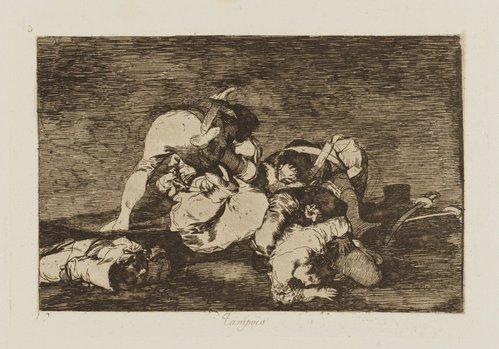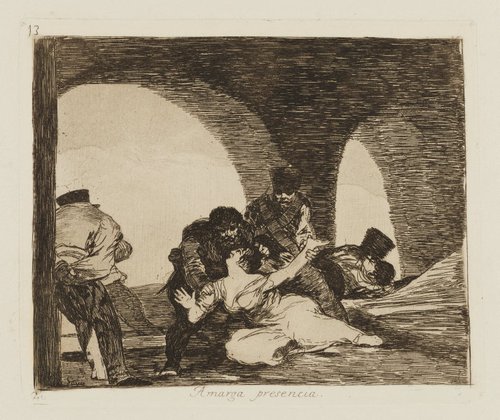Title
Sad forebodings of what is going to happen, from Disasters of War
1810-1813
printed 1863
Artist
-
Details
- Other Title
- Plate 1. Sad foreboding of what is going to happen / Sad presentiments of what must come to pass
- Alternative title
- Tristes presentimientos de lo que ha de acontecer
- Dates
- 1810-1813
printed 1863 - Media category
- Materials used
- etching, burin, drypoint and burnisher
- Edition
- First edition of 1863
- Dimensions
- 14.9 x 19.0 cm image; 17.5 x 22.0 cm platemark; 24.9 x 34.2 cm sheet
- Signature & date
Not signed. Not dated.
- Credit
- Purchased with assistance from Ashley Dawson-Damer AM 2019
- Location
- Not on display
- Accession number
- 125.2019.1
- Copyright
- Artist information
-
Francisco de Goya Y Lucientes
Works in the collection
- Share
-
-
About
The 'Disasters of War' was made in response to the horrors Goya witnessed during the Peninsular War between Spain (assisted by the British army under the Duke of Wellington) and Napoleonic France in 1808–14. The war began when Napoleon invaded Portugal to gain control of the Iberian Peninsula and then turned on Spain. It remains as the bloodiest episode in Spain’s modern history.
Goya’s original title for the series was: 'Fatal consequences of the bloody war in Spain with Bonaparte'. The etchings were carried out over a number of years as events in Spain unfolded.Goya created the 80 etchings and aquatints that comprise the 'Disasters of War' between 1810 and 1820. The prints were inspired by the Napoleonic invasion and ensuing hostilities between 1808–14 (plates 2–47), the famine in Madrid between 1811–12 (plates 48–64) and the repressive government of the restored Bourbon king, Ferdinand VII (plates 65–80).
Goya’s extraordinary imagery condemns the barbarity of war by showing incidents experienced by ordinary people – summary executions, women being raped, the massacre of soldiers and civilians, corpses being dismembered – rather than recording actual battles or major events. Even so, the series cannot be taken as a work of direct reportage however immediate and real the sources of Goya’s inspiration. The imagery is ultimately the product of a frevid imagination inflamed by anxiety and alarm.
Goya’s devised terse, ironic captions for his plates and these add an extra dimension of meaning (and ambiguity) to the images. The captions were written by Goya on a proof set (now in thew British Museum), and these were subsequently used as a guide for a professional letter engraver when the plates were published eventually. Goya left Spain for good in 1824 because of political oppression, and the series never saw publication in his lifetime. The plates were left with his son Javier for safekeeping. After Javier’s death in 1854 the plates were acquired by the Academia de San Fernando in Madrid who published the first edition of the Disasters in 1863. Eventually, a total of seven editions was produced, the last in 1937.
-
Bibliography
Referenced in 4 publications
-
Pierre Gassier and Juliet Wilson, Goya: his life and work with a catalogue raisonné of the paintings, drawings and engravings, London, 1971, pp 217–22.
-
Tomás Harris, Goya: engravings and lithographs, Oxford, 1964, pp 172–292, nos 121–200.
-
Juliet Wilson Bareau, Goya's prints. The Tomás Harris Collection in the British Museum, London, 1991, pp 43–60.
-
Prints & Multiples, London, 13 Jun 2019, p 22, no 33, illus pp 22–23.
-
-
Provenance
Private Collection, pre 1992, Barcelona/Catalonia/Spain
Private Collection, 1992-13 Jun 2019, Barcelona/Catalonia/Spain




